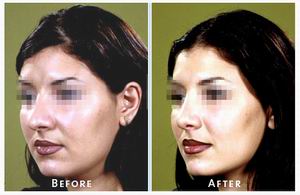
Tip-plasty is a specialized form of rhinoplasty focused exclusively on reshaping and enhancing the nasal tip. Unlike full rhinoplasty, which addresses the entire nose, tip-plasty concentrates on refining the nasal tip’s shape, projection, rotation, and symmetry. This procedure is ideal for patients seeking subtle yet impactful improvements to the nasal tip without altering the bridge or other nasal structures.
The nasal tip plays a vital role in the overall facial balance and aesthetics. Even minor imperfections such as bulbosity, asymmetry, or drooping can affect facial harmony and self-confidence. Advances in surgical techniques allow for precise sculpting of the delicate cartilage and soft tissue that define the nasal tip, producing natural, long-lasting results.
This article explores the causes and risk factors leading patients to opt for tip-plasty, symptoms and signs indicating the need, diagnostic evaluations, treatment options, prevention and management strategies, potential complications, and considerations for living with and after tip-plasty.
Causes Leading to Tip-Plasty
-
Bulbous Nasal Tip: Excess cartilage causing a rounded, wide appearance.
-
Boxy Tip: Lack of definition with broad, square-shaped tip.
-
Drooping or Ptotic Tip: Tip points downward due to cartilage weakness or aging.
-
Overprojected or Underprojected Tip: Tip sticks out too far or is recessed relative to the face.
-
Asymmetrical Tip: Unevenness caused by congenital deformities, trauma, or prior surgery.
-
Thick or Thin Skin: Skin thickness can mask or exaggerate tip shape irregularities.
Risk Factors
-
Previous Nasal Trauma: Can cause cartilage deformities or scarring.
-
Prior Rhinoplasty: May create complex anatomy requiring revision tip-plasty.
-
Aging: Loss of structural support leading to tip drooping.
-
Genetic Factors: Influence cartilage strength and nasal shape.
-
Medical Conditions: Poor wound healing or connective tissue disorders may impact surgical outcomes.
-
Dissatisfaction with Nasal Tip Appearance: Bulbous, droopy, asymmetric, over- or underprojected tip.
-
Functional Issues: Sometimes tip deformities affect nasal airflow.
-
Physical Signs: Visible bulbosity, lack of definition, drooping, or asymmetry.
-
Emotional Impact: Reduced self-esteem or social discomfort related to nasal appearance.
Clinical Examination
-
Comprehensive nasal examination assessing tip shape, skin thickness, cartilage strength, and symmetry.
-
Evaluation of nasal function including airflow testing.
-
Photographic analysis with frontal, basal, and lateral views.
-
Palpation of cartilage to determine deformities.
Imaging (When Needed)
-
3D Imaging or CT Scan: For complex revision cases or combined deformities.
Patient Consultation
-
Detailed discussion about aesthetic goals, functional concerns, and surgical options.
-
Psychological evaluation to ensure realistic expectations.
Surgical Techniques
-
Cartilage Reshaping: Trimming, suturing, or repositioning lower lateral cartilages to refine tip shape.
-
Tip Grafting: Adding cartilage grafts (from septum, ear, or rib) for augmentation or support.
-
Tip Rotation: Adjusting the tip’s angle upward or downward.
-
Tip Deprojection: Reducing tip projection for a balanced profile.
-
Tip Projection: Increasing tip projection when recessed.
-
Alar Base Modification: Narrowing or reshaping nostril base to complement tip changes.
Approaches
-
Open Tip-Plasty: External incision on columella for full exposure, preferred for complex tip corrections.
-
Closed Tip-Plasty: Incisions inside nostrils; suitable for minor reshaping with no external scars.
Anesthesia
-
General anesthesia or local anesthesia with sedation depending on complexity.
Non-Surgical Alternatives
-
Dermal Fillers: Temporary tip augmentation or reshaping; not suitable for major corrections.
Prevention
-
Avoid nasal trauma.
-
Early consultation for tip deformities to plan timely intervention.
Preoperative Management
-
Medical optimization including smoking cessation.
-
Detailed patient education about procedure, risks, and recovery.
-
Preoperative photography and surgical planning.
Postoperative Management
-
Nasal splinting for support during healing.
-
Cold compresses and head elevation to minimize swelling.
-
Pain management and infection prevention.
-
Avoidance of strenuous activity and nasal trauma.
-
Follow-up visits for wound care and monitoring.
Common Side Effects
-
Swelling and bruising around nose and eyes.
-
Temporary numbness or altered sensation.
-
Mild discomfort or pain.
Potential Complications
-
Infection requiring antibiotics.
-
Unsatisfactory aesthetic outcome (overcorrection, asymmetry).
-
Tip numbness or hypersensitivity.
-
Scar formation, though minimal with internal incisions.
-
Cartilage warping or collapse.
-
Need for revision surgery.
Risk Reduction
-
Surgery by an experienced, board-certified facial plastic surgeon.
-
Careful surgical planning and technique.
-
Patient adherence to postoperative instructions.
Recovery Timeline
-
Swelling peaks within 48-72 hours and subsides over 2-3 weeks.
-
Initial return to social activities within 1-2 weeks.
-
Final tip shape and healing may take up to 12 months.
Psychological Benefits
-
Improved self-confidence and facial harmony.
-
Greater satisfaction with facial aesthetics.
Long-Term Care
-
Protect nose from trauma.
-
Avoid excessive sun exposure to prevent pigmentation changes.
-
Maintain regular follow-up visits for long-term assessment.
1. What is Tip-Plasty?
Tip-plasty is a cosmetic surgical procedure that reshapes the nasal tip to improve its appearance and harmony with the rest of the nose. It focuses exclusively on refining the tip without altering the entire nose.
2. Who is a suitable candidate for Tip-Plasty?
Suitable candidates have issues such as a bulbous, droopy, or asymmetrical nasal tip but do not require extensive nasal reconstruction. Candidates should be healthy with realistic expectations.
3. How is the Tip-Plasty procedure performed?
The surgeon makes small incisions inside the nostrils or sometimes on the columella. The cartilage at the nasal tip is reshaped to create a more refined contour, and the incisions are closed with fine sutures.
4. How long does Tip-Plasty surgery take?
The procedure usually takes about 1 to 2 hours, depending on the complexity of reshaping required.
5. What type of anesthesia is used for Tip-Plasty?
Tip-plasty can be performed under local anesthesia with sedation or general anesthesia, depending on the patient's comfort and the surgeon’s recommendation.
6. What should I expect during the recovery period?
Recovery is quick, with most patients returning to normal activities within a few days. Mild swelling or bruising around the cheeks may last about a week.
7. Are the results of Tip-Plasty permanent?
Yes, the surgical changes are permanent, but natural aging can gradually alter nasal appearance over many years.
8. What are the risks or complications of Tip-Plasty?
Possible risks include infection, bleeding, asymmetry, or scarring. Choosing a qualified and experienced surgeon minimizes these risks.
9. Can Tip-Plasty be combined with other procedures?
Yes, Tip-Plasty can be combined with other nasal surgeries, such as rhinoplasty or septoplasty, to achieve overall nasal improvement.
10. How much does Tip-Plasty typically cost?
The cost varies by location, surgeon expertise, and facility fees. It’s best to consult directly with a surgeon for an accurate quote.
The other Cosmetic Procedures are:
Few Popular Hospitals for Tip-Plasty are:
Thailand, Malaysia, Singapore, Turkey and India are the most cost effective locations that offer up to almost 80% savings in comparison to the US.
SurgeryPlanet facilitates a plethora of services to the medical treatment traveler also which includes, a hassle free and discounted travel option, a welcome hand at the airport on arrival, travel in an air-conditioned car, round the clock service & support. Your medical evaluation is pre arranged with the least of waiting time. Once your assessment is complete and found medically fit, the procedure is immediately scheduled without a waiting period. Please read through our Services and Testimonials to understand and select your best options.
Major Treatments Abroad: Obesity / Bariatric Surgery | Spine Surgery | Stem Cell therapy | Fertility treatment | Knee replacement in India and Thailand | Heart Surgery | Organ transplant | Ayurveda Treatment | Heart valve replacement | Hip resurfacing | Hospitals in India and Thailand for Laparoscopic Sterilization| Best hospitals in Asia | JCI & ISO certified Hospitals | Cost effective medical procedures | Healthcare tourism | Complete privacy for affordable cost | Weight loss procedures | Infertility treatment | Board certified physicians | Low cost surgeries
SurgeryPlanet is an Healthcare Facilitator and not a Medical service provider. The information provided in this website is not to be used for diagnosis or treatment of any medical condition or use for any medical purposes. We provide information solely for medical travel facilitation and do not endorse any particular health care provider, hospital, facility, destination or any healthcare service or treatment listed. We are not an agent for, or affiliated to any health care provider, or service listed in our website and is not responsible for health care services provided by them. Choice of hospital or doctor for your healthcare services is your independent decision. Consult your domestic licensed health care provider before seeking the services of any health care provider you learn about from our website.



